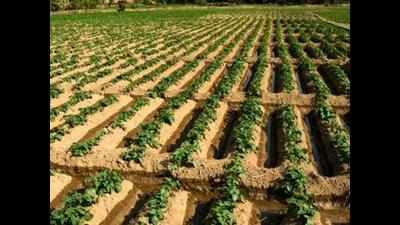- News
- City News
- mangaluru News
- After nearly a decade, vanilla cultivation returns to K'taka
Trending
This story is from July 9, 2016
After nearly a decade, vanilla cultivation returns to K'taka
Shivamogga/ After a lull for nearly a decade, farmers in Karnataka appear to have returned to vanilla cultivation.

Representative image.
Shivamogga/Mangaluru: After a lull for nearly a decade, farmers in Karnataka appear to have returned to vanilla cultivation. Buoyed by the surging price of vanilla in the market, farmers in small pockets of Shivamogga, Kodagu, Karwar and Chikkamagaluru have taken up production of the spice, albeit on a significantly reduced scale.
While there is no official data available with the horticulture department, farmers said that vanilla was cultivated in more than 500 hectares across Shivamogga, Udupi, Karwar, Hassan and Madikeri districts between 2000-07.However, vanilla is being grown on less than 5 hectares this year.
The price of a single kilogram of dry processed vanilla beans has spiked to a 4-year high, hovering between Rs 12,000-13,000 and the price for raw green beans has also surged to Rs 3,500-4,000 per kg. Industry experts believe that the prices are likely to remain stable till the next harvesting season.
Senior manager of Vanilla India Producer Company in Calicut, TV Thomas attributes the sharp increase in the price to vanilla's scarcity across the world and particularly in Madagascar, the largest producer of the crop in the world. "The decline in production is largely owing to disease that the crops have been infested by," he said.
Vanilla's impressive returns even saw nationalised banks coming forth to offer loans to farmers to cultivate the crop that is dubbed 'Green Gold'.
Dwindling demand for the crop, coupled with a brown spot disease caused by fungus Phytophthora brought the price of 1 kg of dry beans crashing down to Rs 300 in 2007, forcing farmers to forsake large scale vanilla cultivation.
The availability of synthetic vanilla, which is significantly cheaper than its natural counterpart, was another factor that resulted in the crop's prices tumbling. However, the promise of a good harvest, coupled with attractive prices for the crop seems to have reignited interest among farmers in the region for vanilla cultivation.
"But farmers are not as keen as they were a decade ago. Those who have been cultivating the spice for years are continuing with it. Moreover, these prices might not last for long since the harvest in Madagascar has been good this year," said Thomas.
Echoing Thomas's observations, the founder of Vanilla Growers' Trust, Hiriyadka Kannangi Sheshadri pointed out that the crop's susceptibility to disease and farmers' poor experiences in the past were discouraging them from taking up large scale cultivation of vanilla.
"A few farmers in Teerthahalli in Shivamogga, Sirsi and Yellapur in Karwar and some places in madikeri have started vanilla cultivation," he added.
Udupi's Kudi Srinivas Bhat is also sceptical of more farmers taking to growing vanilla. "Vanilla cultivation takes 18 to 24 months and the prices may come down in that time," he said.
While there is no official data available with the horticulture department, farmers said that vanilla was cultivated in more than 500 hectares across Shivamogga, Udupi, Karwar, Hassan and Madikeri districts between 2000-07.However, vanilla is being grown on less than 5 hectares this year.
The price of a single kilogram of dry processed vanilla beans has spiked to a 4-year high, hovering between Rs 12,000-13,000 and the price for raw green beans has also surged to Rs 3,500-4,000 per kg. Industry experts believe that the prices are likely to remain stable till the next harvesting season.
Senior manager of Vanilla India Producer Company in Calicut, TV Thomas attributes the sharp increase in the price to vanilla's scarcity across the world and particularly in Madagascar, the largest producer of the crop in the world. "The decline in production is largely owing to disease that the crops have been infested by," he said.
Cultivation of vanilla peaked in the state at the turn of the millennium and lasted till 2007. At one juncture, a single kilogram of dry beans could fetch Rs 25,000-28,000 and farmers even succeeded in turning profits by selling vanilla vines at an enviable price of Rs 100 per metre. There were even reports of vanilla vine thefts at plantations, and farmers even took to growing the spice on rooftops.
Vanilla's impressive returns even saw nationalised banks coming forth to offer loans to farmers to cultivate the crop that is dubbed 'Green Gold'.
Dwindling demand for the crop, coupled with a brown spot disease caused by fungus Phytophthora brought the price of 1 kg of dry beans crashing down to Rs 300 in 2007, forcing farmers to forsake large scale vanilla cultivation.
The availability of synthetic vanilla, which is significantly cheaper than its natural counterpart, was another factor that resulted in the crop's prices tumbling. However, the promise of a good harvest, coupled with attractive prices for the crop seems to have reignited interest among farmers in the region for vanilla cultivation.
"But farmers are not as keen as they were a decade ago. Those who have been cultivating the spice for years are continuing with it. Moreover, these prices might not last for long since the harvest in Madagascar has been good this year," said Thomas.
Echoing Thomas's observations, the founder of Vanilla Growers' Trust, Hiriyadka Kannangi Sheshadri pointed out that the crop's susceptibility to disease and farmers' poor experiences in the past were discouraging them from taking up large scale cultivation of vanilla.
"A few farmers in Teerthahalli in Shivamogga, Sirsi and Yellapur in Karwar and some places in madikeri have started vanilla cultivation," he added.
Udupi's Kudi Srinivas Bhat is also sceptical of more farmers taking to growing vanilla. "Vanilla cultivation takes 18 to 24 months and the prices may come down in that time," he said.
End of Article
FOLLOW US ON SOCIAL MEDIA










